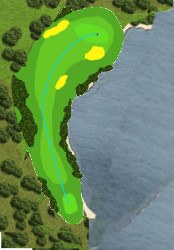
In golf, a “cape hole” refers to a specific type of hole design that incorporates a large body of water or hazard that juts into the fairway, creating a risk-reward scenario for the golfer. It is a strategic design feature that adds excitement and challenge to the hole.
A cape hole typically features a fairway that bends around the water hazard, resembling the shape of a cape or peninsula. The golfer must decide whether to play it safe and hit their tee shot to a narrower section of the fairway away from the water or take a more aggressive line by attempting to carry the hazard and gain a significant advantage in distance.
The risk-reward aspect of a cape hole comes into play because successfully carrying the water hazard can provide a shorter approach shot to the green, potentially setting up a birdie opportunity. However, if the golfer fails to clear the water, they may find their ball in the hazard, leading to a penalty stroke and the need to take a drop.
Cape holes often require accurate shot placement and strategic decision-making. The golfer must assess their skill level, confidence, and the prevailing course conditions before determining the best approach to the hole. They need to weigh the potential rewards against the risks involved in attempting to carry the water hazard.
Cape holes can be found on various golf courses, both professional and recreational, and they are designed to add variety and challenge to the overall course layout. They test a golfer's skill, shot selection, and ability to manage risk, making them memorable and exciting holes to play.
A hole with a severe dogleg (up to 90° from tee to green) around a large water hazard or similar obstacle; the golfer must decide how much of the hazard to carry with his tee shot – more carry means more risk, but results in a shorter approach to the green if executed properly. The 14th hole at National Golf Links on Long Island is considered the original Cape Hole and has been widely copied.





